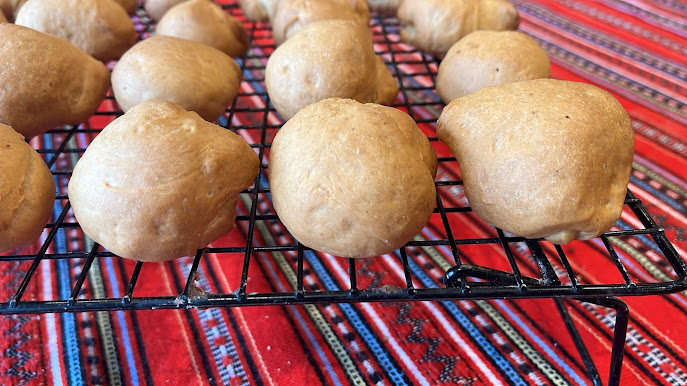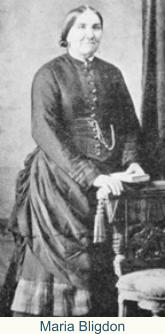Dorset Knobs
In most English-speaking countries, a biscuit is a hard, baked product, the name deriving from the Latin 'bis coctus' or 'twice-baked'. In the United States and Canada, it's often referred to as a 'cookie'. However, strictly speaking, a cookie is unleavened. Mind you, the vast majority of biscuits are unleavened. In South Africa, they're often called beskuit and these are so 'twice-baked' as to be rusks.
But, not all biscuits are unleavened. The Angel biscuit, for example, is leavened with baking soda.
But, here at BreadClub20, we only specialise in bread or baked products that are leavened using natural or baker's yeasts. We wouldn't focus on a biscuit, cake, cookie or scone.
Enter, the Dorset Knob.
Dorset Knobs are unique. They are formed from traditionally fermented dough; hard, dry and very crumbly.
But why are they called 'Knobs? Well, they take their name from the traditional Dorset Knob button
Dorset Knobs (the baked product, not the buttons) are steeped in tradition. Below, you'll find the complete story of Mrs Bligdon's Bakery and the Birth of the Dorset Knob. I encourage you to read this fascinating insight into a slice of English baking.
These days, the Dorset Knob is only baked by one company, Moores of Bridport, near Lyme Regis in Dorset. They've been baking the Dorset Knob since 1880.
 |
| The Moores Bakery - family and Staff 1880. |
The writer, Thomas Hardy, was extremely fond of a Dorset Knob. The author's maid, Nellie Titterington, revealed that the author "would most enjoy a cup of soup, followed by two boiled eggs. He finished his meal with Dorset knobs and Stilton cheese, both favourites of Mr Hardy,:
Down in Cattistock, the Dorset Knob Throwing Competition has been held every July for the last 62 years. Three Dorset Knobs are thrown, underarm, and the furthest measured is declared the winner. In addition, family events such as Knob Painting, Guess the Weight of the Big Knob, Knob Darts and Build a Knob Pyramid always prove hugely entertaining.
But, we're being side-tracked. We mustn't lose sight of the fact the Dorset Knob is a significant piece of British baking. They are prepared and baked with care. The process of making these hand-rolled buns takes many hours with bakings taking up to three hours.
As Thomas Hardy knew, the best way to enjoy a Dorset Knob is as part of 'Thunder and Lightning' - a Dorset Knob accompanying a slice of Blue Vinny Stilton cheese or with honey and cream...oh, and don't forget the cider!
This recipe is adapted from Albert The Tall, who hailed from Upway in Dorset and documented in 1898 how to bake Dorset Knobs.
INGREDIENTS300 gms strong white bread flour
150 gms plain or lower-protein All-Purpose flour
16 gms caster sugar
120 gms tepid water
50 gms of unsalted butter (softened)
4 gms crushed sea salt
7 gms of active dried yeast
Have some oil to hand to enable you to shape the dough on your work surface
If you want to make your Dorset Knobs using sourdough leaven then I recommend the following to assist you in your conversions.
https://breadtopia.com/faq/how-to-convert-recipes-between-sourdough-and-yeast/
METHOD
Take ⅓ of the sugar and 100 gms of the water and add to the yeast. Stir well and leave to one side until it becomes active and frothy.
Mix the flour and the salt with the rest of the sugar. Add the butter and the yeast mixture and bring together into a stiff mix.
Into a well in the centre of the dough mixture add half of the remaining water and knead. Continue to knead and add just enough water to make a soft but firm dough.
Place the dough in a lightly oiled bowl, cover and allow to proof until doubled.
Tip the dough out onto a lightly oiled board and de-gas it (also called 'knocking back').
Roll the dough out into a rough rectangle approximately 1cm thick.
Cut the dough into 2cm squares and then take each square and roll it under your palm until you have formed a ball.
Place each ball on a prepared baking sheet. Keep approximately 5 cm apart to allow for spreading and then gently flatten out the tops slightly.
Cover with a cloth and keep in a warm place until they have doubled in size.
Once doubled, preheat your oven to 190⁰C and bake for 15 minutes.
Remove from the oven and allow to cool completely.
When cool.......
Set the temperature of the oven to 130⁰C and return the knobs to the oven for a further 2 hours.
Remove and place on a rack. Allow to cool completely.
Serve the Dorset Knobs with Stilton or Dorset Blue Vinny cheese or with cream or butter and jam or chutney. Wash down with a glass of fine old-fashioned cider or a good cup of tea.
Mrs Bligdon’s Bakery and the Birth of the Dorset Knob
This is the story of a Dorset woman who owned and ran the bakery where the first Dorset Knobs were baked. Maria Bligdon could not claim to have conceived the recipe for the delicacy but she was certainly instrumental in its birth and growth in popularity, particularly in West Dorset, where it is still produced.
In 1815, Fordington was a densely populated parish on the edge of the county town of Dorchester. Living conditions there were filthy and squalid, so it is difficult to imagine what could have brought William Pitcher to this place from Powerstock, where he would have enjoyed a rural lifestyle with fresh air in abundance. The same could be said of Maria Longman who came from Rimpton Mill near Yeovil, just over the county border in Somerset. It is possible these two young people knew each other previously or may even have travelled there together because on the 22nd of March 1815 they were married at St. Georges Church.
After marrying they didn’t linger in Fordington; they travelled through Dorchester they headed west, settling in the parish of Litton Cheney. Here, they would have been more at home. The stone and thatched cottages, many dating back to the 17th century at ease beside the twisting lanes and busy streams, would have been much more to their liking than the over-crowded tenements of the Dorchester suburb.
William and Maria would have worshipped here at the original church dedicated to St. Mary; what we see today is the result of an extensive restoration completed in 1878. It is at St. Mary’s their children were all baptised: Jesse on 11th of August 1816; Mary Brown on 31st of May 1818; John on 5th of March 1820; Nimshi on 13th of October 1822; Levi on 26th of March 1824; Daniel on 9th of September 1826; Maria Brown on 11th of August 1828; Elizabeth Martha Longman on 25th of July 1830 (Buried on 10th of May 1836); William Longman Brown on 19th of May 1833; and Jane on 18th of December 1834 (Buried on 4th of January 1835.) Brown is a reference to grandmother Pitcher’s maiden name.
William Pitcher was born at Powerstock, where he was baptised on Christmas Day 1789. William was the first son of Samuel and Mary Pitcher and he was a miller. Maria Longman, his wife, was born in 1795 at Rimpton Mill, which is near Yeovil and not so very far away from the Dorset town of Sherborne.
William handed down his knowledge of milling and baking to his children. In 1851 we find his eldest son, Jesse, working as a journeyman miller at Malassie Mill, St. Savior, Jersey; Levi was working as a miller at Notton Mills, Maiden Newton and William was a Journeyman Baker still living with his parents. One son, William, was a tailor by trade and lived at Portesham.
But it is their daughter Maria who is of particular interest to us. By all accounts she was a formidable woman with striking looks and great strength; reputedly she could handle a sack of flour as well as any man and was known for having her own way.
The business started in a small way with one assistant but quickly grew. Bakery products were delivered by horse and cart to villages with in a radius of about ten miles. In 1881 many villages in Dorset were cut off for days because of deep snow. To meet the pressing need of some of the villages her horses were shod with special nails that prevented slipping, the bread was packed into panniers slung on each side of the horses and a convoy set off on its difficult journey to reach some of the more distant customers.
In 1881 Maria Bligdon employed three bakers and two servants, all living on the premises. Her husband continued his business as a cordwainer. One of these bakers, a Mr Moores, brought with him a recipe for Dorset Knobs, a round savoury biscuit that quickly became a favourite with the customers. It is named after the Dorset knob button. The recipe consists of bread dough to which extra sugar and butter are added. The dough is then shaped by hand and baked three times; the result is very crumbly and similar to a rusk.
Nellie Titterington, Thomas Hardy’s, parlour maid, revealed that the author “would most enjoy a cup of soup, followed by two boiled eggs. He finished his meal with Dorset knobs and Stilton cheese, both favourites of Mr Hardy, Dorset knobs especially.”
With fat bacon the Dorset Knob formed the main diet of the men employed by Maria Bligdon at her Litton Cheney bake house and the biscuits were despatched to Dorset soldiers fighting in Africa during the Boer Wars.
Pound Cake was another speciality of the bakery and sold for sixpence a pound; her gooseberry tart was also very popular. A custom from the old days was the making of dough cake; the dough was supplied by the bakery to the villagers who made it into cakes which were baked at the bake house.
Those less fortunate, living off parish relief and seeking employment, were given penny bread tickets, which the bakery accepted towards the cost of a loaf of bread, at that time about four pence. The bakery would accept about £5 worth of tickets every month. Given that in those days there were two hundred and forty pence to the pound we can see Mrs Bligdon’s bakery was very busy.
Maria Bligdon was buried at Litton Cheney on 8th of January 1891 aged 63. Her husband, John, died in 1896. It is said that one of their sons took over the business and closed it in 1916. We have found no record of any children and believe it was a nephew who took over the business.
When Mr Moores left the bakery he went to Morcombelake where his sons started a business and produced Dorset Knobs. That business is still in existence today and during January and February the firm continues to bake Dorset Knobs, which are retailed mainly through smaller grocery outlets and exported.
There's also a Real Ale named after the Dorset Knob!














Comments
Post a Comment